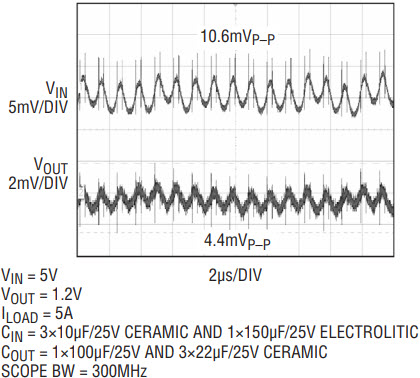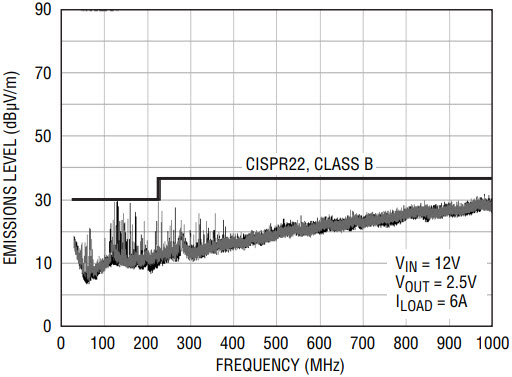Ultralow Noise 15mm × 15mm × 2.8mm µModule Step-Down Regulators Meet the Class B of CISPR 22 and Yield High Efficiency at up to 36VIN
Ultralow Noise 15mm × 15mm × 2.8mm µModule Step-Down Regulators Meet the Class B of CISPR 22 and Yield High Efficiency at up to 36VIN
2009年01月01日
Introduction
Power supply designers face many tradeoffs. Need high efficiency, large conversion ratios, high power and good thermal performance? Choose a switching regulator. Need low noise? Choose a linear regulator. Need it all? Compromise. One compromise is to follow a switcher with a linear regulator (or regulators). Although this cleans up the output noise relative to a switcher-only solution, a good portion of the conducted and radiated EMI remains—even if ferrite beads, π filters, and LC filters are used. The problem can always be traced back to the switcher, where fast dI/dt transitions and high switching frequencies lead ttableo high frequency EMI, but some applications, especially those with large conversion ratios, require a switcher.
Fortunately, the LTM4606 and LTM4612 µModule regulators offer the advantages of a switching regulator while maintaining ultralow conducted and radiated noise. These µModule step-down regulators are designed to achieve both high power density and meet EMC (electromagnetic compatibility) standards. The integrated ultralow noise feature allows both devices to pass the Class B of CISPR 22 radiated emission limit, thus eliminating expensive EMI design and lab testing. See Table 1 for a feature comparison of these two parts.
| Feature | LTM4606 | LTM4612 |
| VIN | 4.5V to 28V | 5V to 36V |
| VOUT | 0.6V to 5V | 3.3V to 15V |
| IOUT | 6A DC Typical, 8A Peak | 5A DC Typical, 7A Peak |
| CISPR 22 Class B Compliant | • | • |
| Output Voltage Tracking and Margining | • | • |
| PLL Frequency Synchronization | • | • |
| ±1.5% Total DC Error | • | • |
| Power Good Output | • | • |
| Current Foldback Protection | • | • |
| Parallel/Current Sharing | • | • |
| Low Input and Output Referred Noise | • | • |
| Ultrafast Transient Response | • | • |
| Current Mode Control | • | • |
| Programmable Soft-Start | • | • |
| Output Overvoltage Protection | • | • |
| Package | 15mm × 15mm × 2.8mm | 15mm × 15mm × 2.8mm |
Both µModule regulators are offered in space saving, low profile and thermally enhanced 15mm × 15mm × 2.8mm LGA packages, so they can be placed on the otherwise unused space at the bottom of PC boards for high-accuracy point-of-load regulation. This is not possible with linear regulators that require a bulky cooling system. Almost all support components are integrated into the µModule package, so layout design is relatively simple, requiring only a few input and output capacitors.
For more output power, both parts can be easily paralleled, where output currents are automatically shared due to the current mode control structure.
Easy Power Supply Design with Ultralow Noise µModule Regulators
With a few external input and output capacitors, the LTM4612 can deliver 4.5A of DC output current and the LTM4606 can deliver 6A. The LTM4612’s programmable output can be precisely regulated in a 3.3V-to-15V range from a 4.5V-to-36V input; the LTM4606 can produce 0.6V to 5V from a 4.5V-to-28V range. With current mode control and optimized internal compensations, both offer stable output even in the face of significant load transients.
Figure 1 shows the simplified block diagram of the LTM4606 with an input from 4.5V to 28V and 2.5V/6A output. Figure 2 shows the efficiency test curves with 12V input voltage under CCM mode. About 92% efficiency is achieved at full load with LTM4606, running at 900kHz switching frequency.

Figure 1. Simplified block diagram of the LTM4606 (LTM4612 is similar). Only a few capacitors and resistors are required to build a complete wide-input-range regulator.

Figure 2. Efficiency of the LTM4606 with a 12V input.
Figure 3 shows a complete 18V–36V VIN, 12V/4.5A VOUT design with the LTM4612. Figure 4 shows the efficiency.

Figure 3. A few capacitors and resistors complete an 18V–36V input, 12V/4.5A output design.

Figure 4. Efficiency for the circuit in Figure 3.
Both parts offer good thermal performance with a large output load current. Figure 5 shows the LTM4606 thermal image with 24V input and 3.3V output at 6A load current. The maximum case temperature is only 73.5°C with the 20W output power.

Figure 5. Thermal image of an LTM4606 with 24V input and 3.3V output at 6A.
Both include a number of built-in features, such as controllable soft-start, RUN pin control, output voltage tracking and margining, PGOOD indicator, frequency adjustment and external clock synchronization. Efficiency can be further improved by applying an external gate driver voltage to the DRVCC pin, especially in high VIN applications. Discontinuous mode operation can be enabled to increase the light load efficiency.
Reduce Conducted EMI
Conducted input and output noise of switching regulators (aka ripple) is usually a problem when the regulator operates at high frequency, which is common in space-constrained applications. The LTM4606 and LTM4612 reduce peak-to-peak ripple at the input by integrating a high frequency inductor as shown in Figure 6. The external input capacitors at the VD and VIN pins form a high frequency input π filter. This effectively reduces conductive EMI coupling between the module and the main input bus.

Figure 6. Input π filter reduces high frequency input noise.
Since most input RMS current flows into capacitor C3 at the VD pin, C3 should have enough capacity to handle the RMS current. A 10µF ceramic capacitor is recommended. To effectively attenuate EMI, place C3 as close as possible to the VD pin. The ceramic capacitors C2 mainly determine the ripple noise attenuation, so the capacitor value can be varied to meet the different input ripple requirements. C1 is only needed if the input source impedance is compromised by long inductive leads or traces.
Since these µModule regulators are used in a buck circuit topology, the lowpass filter formed by the output inductor L and capacitor COUT can similarly reduce the conducted output EMI.
To show the relative noise attenuation of these µModule regulators, a similar module without the low noise feature is compared to the LTM4606 for input and output noise, as shown in Figure 7 and Figure 8. Both modules are tested from 5V input to 1.2V output at 5A with resistive loads. The same board layout and I/O capacitors are used in the comparison. The results show that the LTM4606 produces much lower input and output noise, with a nearly 10× reduction of the peak-to-peak input noise and better than 3× reduction of the output noise compared to the similar module in Figure 7.

Figure 7. Input and output noise of comparable µModule regulator without low noise feature.

Figure 8. Input and output noise of LTM4606 µModule regulator is significantly lower than the regulator in Figure 7.
Figure 9 shows the conducted EMI testing results for the LTM4612 with a 24V VIN, 12V/5A VOUT, which accommodates the EMI standard CISPR 25 level 5. The input capacitance for this test comes from 4 × 10µF/50V ceramics plus a single 150µF/50V electrolytic.

Figure 9. The conducted EMI test of the LTM4612 passes EMI standard CISPR 25 level 5.
Reduce Radiated EMI
Switching regulators also produce radiated EMI, caused by the high dI/dt signals inherent in high efficiency regulators. The input π filter helps to limit radiated EMI caused by high dI/dt loops in the immediate module area, but to further attenuate radiated EMI, the LTM4606 and LTM4612 include an optimized gate driver for the MOSFET and a noise cancellation network.
To test radiated EMI, several setups are tested in a 10-meter shielded chamber as shown in Figure 10. To ensure a low baseline radiated noise, a linear DC power supply is used for the input, and a resistive load is employed on the output. The baseline noise is checked with the power supply providing a DC current directly to the resistive load. The baseline emission scan results are shown in Figure 11. There are two traces in the plot, one for the vertical and horizontal orientations of the receiver antenna.

Figure 10. Setup of the radiated emission scan.

Figure 11. Radiated emission scan of baseline noise (no switching regulator module).
Figure 12 shows the peak scan results of a µModule buck regulator—not the LTM4606 or LTM4612—without the integrated low noise feature. The scan results show that the noise below 350MHz is produced by the µModule switching regulator, when compared to the baseline noise level. Radiated EMI here does not meet the Class B of CISPR 22 (quasi-peak) radiated emission limit.

Figure 12. Radiated emission peak scan of a typical module without the low noise features.
In contrast, Figure 13 shows the peak scan results of the low noise LTM4606 module. To ensure enough margin to the quasi-peak limit for different operation conditions, the six highest noise points are checked as shown in the table of Figure 13 using the quasi-peak measurement. The results show that it has more than 12dBµV margin below the Class B of CISPR 22(quasi-peak) radiated emission limit.

Figure 13. The radiated EMI test of the LTM4606 passes EMI standard CISPR 22 Class B.
| Frequency (MHz) |
Antenna Polarization |
EUT Azimuth (Degrees) |
Antenna Height (cm) |
Uncorrected Amplitude (dBµV) |
ACF (dB/m) |
Pre-Amp Gain (dB) |
CBL (dB) |
DCF (dB) |
Corrected Amplitude (dBµV) |
Limit (dBµV) |
Margin (dB) |
| 134.31 | H | 354 | 364 | 1.3 | 11.428 | 0 | 1.532 | 0 | 14.26 | 30 | 15.74 |
| 119.96 | V | 184 | 110 | 3.5 | 12.694 | 0 | 1.456 | 0 | 17.65 | 30 | 12.35 |
| 160.02 | H | 0 | 354 | 0.5 | 10.499 | 0 | 1.793 | 0 | 12.792 | 30 | 17.208 |
| 174.37 | H | 0 | 100 | 1.2 | 9.638 | 0 | 1.944 | 0 | 12.782 | 30 | 17.218 |
| 224.28 | V | 0 | 100 | –1.87 | 10.586 | 0 | 2.044 | 0 | 10.76 | 30 | 19.24 |
| 263.63 | H | 0 | 371 | –4.72 | 12.6 | 0 | 2.385 | 0 | 10.265 | 37 | 26.735 |
Figure 14 shows the results for the LTM4612 meeting the Class B of CISPR 22 radiated emission limit at 24V VIN, 12V/5A VOUT.

Figure 14. The radiated EMI test of the LTM4612 passes EMI standard CISPR 22 Class B.
Conclusion
The LTM4606 and LTM4612 µModule regulators offer all of the high performance benefits of switching regulators minus the noise issues. The ultralow noise optimized design produces radiated EMI performance with enough margin below the Class B of CISPR 22 limit to simplify application in noise-sensitive environments.
Design is further simplified by exceptional thermal performance, which allows them to achieve high efficiency and a compact form factor. A low profile 15mm × 15mm × 2.8mm package contains almost all of the support components—only a few input and output capacitors are required to complete a design. Several µModule regulators can be easily run in parallel for more output power. The versatility of these parts is rounded out by optional features such as soft-start, RUN pin control, output voltage tracking and margining, PGOOD indicator, frequency adjustment and external clock synchronization.




















